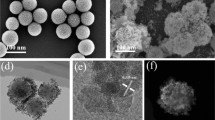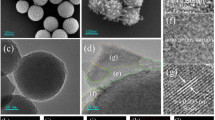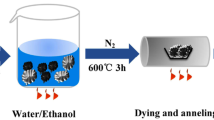Abstract
In this work, a spherical Sn-MOF precursor was synthesized through hydrothermal method using 1,3,5-benzenetricarboxylic acid (H3BTC) as the organic ligand. Sn-MOF-200, Sn-MOF-250, and Sn-MOF-300 were obtained at different annealing temperatures. Among them, the Sn-MOF-250 composite obtained by annealing at 250 ℃ was stable in structure, and the specific surface area is 118.8 m2 g−1. The specific capacity of Sn-MOF-250 can be maintained up to 846.6 mA h g−1 after 110 cycles at the current density of 100 mA g−1 when used as the anode material of lithium-ion battery. The excellent cycling performance of Sn-MOF-250 is due to the special framework structure of metal–organic frameworks (MOFs). After combining with Sn ion, the metal–organic coordination compound formed can greatly improve the diffusion and transport efficiency of lithium ion. This facile synthesis strategy has a certain application prospect in the development of high-performance lithium-ion battery anode materials.








Similar content being viewed by others
Data availability
All data generated or analyzed during this study are included in this published article.
References
Zheng JC, Yang Z, Dai A, Tang L, Lu J (2019) Boosting cell performance of LiNi0.8Co0.15Al0.05O2 via surface structure design. Small 15:1904854
Liu Y, Tang LB, Wei HX, Zhang XH, He ZJ, Li YJ, Zheng JC (2019) Enhancement on structural stability of Ni-rich cathode materials by in-situ fabricating dual-modified layer for lithium-ion batteries. Nano Energy 65:104043
Shen X, Liu H, Cheng XB, Yan C, Huang JQ (2018) Beyond lithium-ion batteries: higher energy density battery systems based on lithium metal anodes. Energy Stor Mater 12:161–175
Tian H, Qin P, Li K, Zhao Z (2020) A review of the state of health for lithium-ion batteries: research status and suggestions. J Clean Prod 261:120813
Meduri P, Pendyala C, Kumar V, Sumanasekera GU, Sunkara MK (2009) Hybrid tin oxide nanowires as stable and high capacity anodes for Li-ion batteries. Nano Lett 9:612–616
Liu LH, Xie F, Lyu J, Zhao T, Li T, Choi BG (2016) Tin-based anode materials with well-designed architectures for next-generation lithium-ion batteries. J Power Sources 321:11–35
Gao CW, Jiang ZJ, Wang PX, Jensen LR, Zhang YF, Yue YZ (2020) Optimized assembling of MOF/SnO2/graphene leads to superior anode for lithium ion batteries. Nano Energy 74:104868
Li R, Nie SQ, Miao C, Xin Y, Mou HY, Xu GL, Xiao W (2022) Heterostructural Sn/SnO2 microcube powders coated by a nitrogen-doped carbon layer as good-performance anode materials for lithium ion batteries. J Colloid Interface Sci 606:1042–1054
Xiao XY, Zhao FJ, Liu J, Wang Z, Sui QX, Tan MX (2021) Synthesis of hexahedron SnS2/C derived from tin metal-organic frameworks (Sn-MOF) as a promising anode for lithium-ion batteries. Mater Lett 296:129877
Lee J, Farha OK, Roberts J, Scheidt KA, Nguyen ST, Hupp JT (2009) Metal–organic framework materials as catalysts. Chem Soc Rev 38:1450–1459
Sculley J, Yuan DQ, Zhou HC (2011) The current status of hydrogen storage in metal-organic frameworks updated. Energy Environ Sci 4:2721–2735
Lauren LE, Leong K, Farha OK, Allendorf M, Duyne RPV, Hupp JT (2012) SERS of molecules that do not adsorb on Ag surfaces: a metal–organic framework-based functionalization strategy. Chem Rev 112:1105–1125
Horcajada P, Chalati T, Serre C, Gillet B, Sebrie C, Baati T, Eubank JF, Heurtaux D, Clayette P, Kreuz C, Chang JS, Huang YK, Marsaud V, Bories PN, Cynober L, Gil S, Ferey G, Couvreur P, Gref R (2010) Porous metal-organic-framework nanoscale carriers as a potential platform for drug delivery and imaging. Nat Mater 9:172–178
Liu L, Guo H, Liu J, Qian F, Zhang C, Li T, Chen W, Yang X, Guo Y (2014) Self-assembled hierarchical yolkshell structured NiO@C from metal-organic frameworks with outstanding performance for lithium storage. Chem Commun 50:9485–9488
Hu L, Huang Y, Zhang F, Chen Q (2013) CuO/Cu2O composite hollow polyhedrons fabricated from metal-organic framework templates for lithium-ion battery anodes with a long cycling life. Nanoscale 5:4186–4190
Shao J, Wan ZM, Liu HM, Zheng HY, Gao T, Shen M, Qu QT, Zheng HH (2014) Metal organic frameworks-derived Co3O4 hollow dodecahedrons with controllable interiors as outstanding anodes for Li storage. J Mater Chem A 2:12194–12200
Lu YY, Zhan WW, He Y, Wang YT, Kong XJ, Kuang Q, Xie ZX, Zheng LS (2014) MOF-templated synthesis of porous Co3O4 concave nanocubes with high specific surface area and their gas sensing properties. ACS Appl Mater Interfaces 6:4186–4195
Xu XD, Cao RG, Jeong S, Cho J (2012) Spindle-like mesoporous α-Fe2O3 anode material prepared from MOF template for high-rate lithium batteries. Nano Lett 12:4988–4991
Banerjee A, Singh U, Aravindan V, Srinivasan M, Ogale S (2013) Synthesis of CuO nanostructures from Cu-based metal organic framework (MOF-199) for application as anode for Li-ion batteries. Nano Energy 2:1158–1163
Hu L, Chen QW (2014) Hollow/porous nanostructures derived from nanoscale metal-organic frameworks towards high performance anodes for lithium-ion batteries. Nanoscale 6:1236–1257
Krause S, Evans JD, Bon V, Senkovska I, Ehrling S, Stoeck U, Yot PG, Iacomi P, Llewellyn P, Maurin G, Coudert FX, Kaskel S (2018) Adsorption contraction mechanics: understanding breathing energetics in isoreticular metal–organic frameworks. J Phys Chem C 122:19171–19179
Park JH, Choi KM, Lee DK, Moon BC, Shin SR, Song M-K, Kang JK (2016) Encapsulation of redox polysulphides via chemical interaction with nitrogen atoms in the organic linkers of metal-organic framework nanocrystals. Sci Rep 6:25555
Wu HB, Lou XWD (2017) Metal-organic frameworks and their derived materials for electrochemical energy storage and conversion: promises and challenges. Sci Adv 3:9252
Wang BJ, Ma SY, Pei ST, Xu XL, Cao PF, Zhang JL, Zhang R, Xu XH, Han T (2020) High specific surface area SnO2 prepared by calcining Sn-MOFs and their formaldehyde-sensing characteristics. Sens Actuators, B 321:128560
Jin LN, Zhao XS, Qian XY, Dong MD (2018) Nickel nanoparticles encapsulated in porous carbon and carbon nanotube hybrids from bimetallic metal-organic-frameworks for highly efficient adsorption of dyes. J Colloid Interface Sci 509:245–253
Liu K, You H, Jia G, Zheng Y, Song Y, Yang M, Huang Y, Zhang H (2009) Coordination-induced formation of one-dimensional nanostructures of europium benzene-1,3,5-tricarboxylate and its solid-state thermal transformation. Cryst Growth Des 9:3519–3524
Hong YJ, Son MY, Kang YC (2013) One-pot facile synthesis of double-shelled SnO2 yolk-shell-structured powders by continuous process as anode materials for Li-ion batteries. Adv Mater 25:2279–2283
Wang MH, Yang H, Zhou XL, Shi W, Zhou Z, Cheng P (2016) Rational design of SnO2@C nanocomposites for lithium ion batteries by utilizing adsorption properties of MOFs. Chem Commun 52:717–720
Sun ZX, Cao C, Han WQ (2015) A scalable formation of nano-SnO2 anode derived from tin metal-organic frameworks for lithium-ion battery. RSC Adv 5:72825–72829
Huang K, Xing Z, Wang L, Wu X, Zhao W, Qi X, Wang H, Ju Z (2018) Direct synthesis of 3D hierarchically porous carbon/Sn composites via in situ generated NaCl crystals as templates for potassium-ion batteries anode. J Mater Chem A 6:434–442
Zhou X, Wan LJ, Guo YG (2013) Binding SnO2 nanocrystals in nitrogen-doped graphene sheets as anode materials for lithium-ion batteries. Adv Mater 25:2152–2157
Huang B, Li X, Pei Y, Li S, Cao X, Masse RC, Cao G (2016) Novel carbon- encapsulated porous SnO2 anode for lithium-ion batteries with much improved cyclic stability. Small 12:1945–1955
Kravchyk K, Protesescu L, Bodnarchuk MI, Krumeich F, Yarema M, Walter M, Guntlin C, Kovalenko MV (2013) Monodisperse and inorganically capped Sn and Sn/SnO2 nanocrystals for high-performance Li-ion battery anodes. J Am Chem Soc 135:4199–4202
Hu Y, Yang QR, Ma J, Chou SL, Zhu M, Li Y (2015) Sn/SnO2@C composite nanofibers as advanced anode for lithium-ion batteries. Electrochim Acta 186:271–276
Zhou X, Chen S, Yang J, Bai T, Ren Y, Tian H (2017) Metal–organic frameworks derived okra-like SnO2 encapsulated in nitrogen-doped graphene for lithium ion battery. ACS Appl Mat Inter 9:14309–14318
Whittingham MS (2014) Ultimate limits to intercalation reactions for lithium batteries. Chem Rev 114:11414–11443
Vetter J, Novák P, Wagner MR, Veit C, Möller KC, Besenhard JO, Winter M, Wohlfahrt-Mehrens M, Vogler C, Hammouche A (2005) Ageing mechanisms in lithium-ion batteries. J Power Sources 147:269–281
Pastor-Fernández C, Uddin K, Chouchelamane GH, Widanage WD, Marco J (2017) A comparison between electrochemical impedance spectroscopy and incremental capacity-differential voltage as Li-ion diagnostic techniques to identify and quantify the effects of degradation modes within battery management systems. J Power Sources 360:301–318
Levi MD, Salitra G, Markovsky B, Teller H, Aurbach D, Heider U, Heider L (2019) Solid-state electrochemical kinetics of Li-ion intercalation into Li1 − xCoO2: simultaneous application of electroanalytical techniques SSCV, PITT, and EIS. J Electrochem Soc 146:1279–1289
Andre D, Meiler M, Steiner K, Wimmer C, Soczka-Guth T, Sauer DU (2011) Characterization of high-power lithium-ion batteries by electrochemical impedance spectroscopy. J Power Sources 196:5334–5341
Liang JM, Zhang LJ, XiLi DG, Kang J (2020) Rational design of hollow tubular SnO2@TiO2 nanocomposites as anode of sodium ion batteries. Electrochim Acta 341:136030
Zhao X, Zhao Y, Liu Z, Yang Y, Sui J, Wang HE (2018) Synergistic coupling of lamellar MoSe2 and SnO2 nanoparticles via chemical bonding at interface for stable and high-power sodium-ion capacitors. Chem Eng J 354:1164–1173
Funding
This work was supported by the Scientific Research Program of Hebei Province (No. 16273706D) and the Basic Innovation Team of Tangshan (2017).
Author information
Authors and Affiliations
Contributions
All authors contributed to the study conception and design. Material preparation, data collection, and analysis were performed by Chonghua Shi, Jiajin Nie, Jianqiang Xie, and Shaowei Yao. The first draft of the manuscript was written by Hang Fu, and all authors commented on previous versions of the manuscript. All authors read and approved the final manuscript.
Corresponding authors
Ethics declarations
Competing interests
The authors declare no competing interests.
Additional information
Publisher's Note
Springer Nature remains neutral with regard to jurisdictional claims in published maps and institutional affiliations.
Supplementary Information
Below is the link to the electronic supplementary material.
Rights and permissions
Springer Nature or its licensor holds exclusive rights to this article under a publishing agreement with the author(s) or other rightsholder(s); author self-archiving of the accepted manuscript version of this article is solely governed by the terms of such publishing agreement and applicable law.
About this article
Cite this article
Fu, H., Shi, C., Nie, J. et al. Lithium storage performance of Sn-MOF-derived SnO2 nanospheres as anode material. J Solid State Electrochem 26, 2919–2928 (2022). https://doi.org/10.1007/s10008-022-05298-5
Received:
Revised:
Accepted:
Published:
Issue Date:
DOI: https://doi.org/10.1007/s10008-022-05298-5




